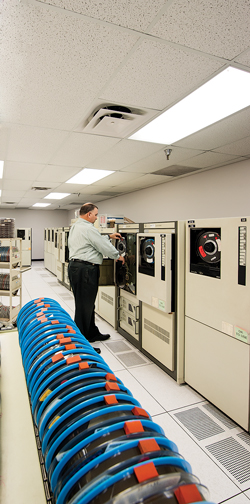What's new in exploration
|
A few weeks ago, I had the opportunity to visit Katalyst Data Management’s offices, here in Houston. Part of the visit included a tour of the premises. Midway through the tour, we exited an aisle facing a wall, and came face-to-face with what I took to be a “junkyard” of discarded equipment. Against the wall were rows of old tape drives—7-, 9- and 21-track tape drives ready to read/write seismic data. Some of the hardware dated back to the early magnetic storage era, probably from the 1970s onward. But, what I took to be a pile of discarded bones was actually a very visual indicator of the company’s commitment to store and manage almost all media types and formats of recorded seismic data. The legacy drives were not discards, but, instead, were intentionally preserved sources of parts for outdated storage technologies, allowing the company to save, manage and retrieve older and legacy data, recorded on even the oldest type of storage media, analog tapes.
Integrated with this old equipment, as I would learn during the visit, was the company’s proprietary software, which enables them to read all standard SEG formats, as well as most oil companies’ internal formats. All in all, it was a unique lesson in the preservation and manipulation of seismic data. But, of course, that data, and those capabilities, are meaningless unless they can be easily accessed by users, for which Katalyst provides an end-to-end solution. Katalyst maintains secure, completely replicated, Tier 2 data centers utilizing widely accepted technology, including the PPDM 3.8 data model for seismic information. The data can be quickly and accurately retrieved from the Katalyst database, called iGlass, through a simple point-and-click process. With the newly-launched SeismicZone, the online data licensing service application, the seismic licensing process is expedited by allowing geoscientists to view available proprietary seismic data 24/7, and select areas of quality-checked data to license, all with the simplicity of a map interface. Since the folks hosting the tour let me play with it, I can tell you honestly that anybody can use the software. There are a few things you should come to the table with, including:
Using those basic parameters, you can narrow your search to locate data available in your area of interest, viewable on a geospatial map. If the 2D line or 3D survey is bigger than you require, you have the ability to cut it to the desired length or size needed. You can also view the seismic data, prior to licensing it, through a QI viewer, which allows you to see randomly sampled in-lines and cross-lines throughout the 3D survey, to check the quality of the data to ensure your area of interest is properly imaged and has the bandwidth needed for interpretation. When you are ready to license, proceed to the order cart. The data owners establish the price of the data, based on location, vintage and fold, as well as any minimum size requirements. Katalyst serves as an agent between the licensor and licensee, handling all of the necessary licenses, which vary from company to company. Once an agreement has been executed, Katalyst will ensure that the proper data are delivered to the licensee. I would encourage you to take a look at Katalyst, as it is a one-stop-shop for all your seismic data management and licensing needs. (https://www.katalystdm.com/). |

- Applying ultra-deep LWD resistivity technology successfully in a SAGD operation (May 2019)
- Adoption of wireless intelligent completions advances (May 2019)
- Majors double down as takeaway crunch eases (April 2019)
- What’s new in well logging and formation evaluation (April 2019)
- Qualification of a 20,000-psi subsea BOP: A collaborative approach (February 2019)
- ConocoPhillips’ Greg Leveille sees rapid trajectory of technical advancement continuing (February 2019)




